Click here to view our special interactive 135th anniversary timeline.
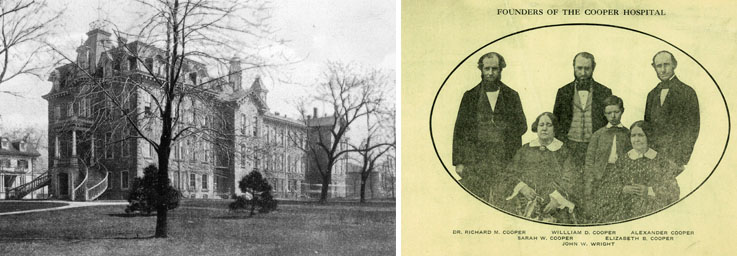
Cooper University Health Care has been a leading provider of health services for the people of Southern New Jersey since 1887. Cooper's mission is: To serve, to heal, to educate.
From its humble beginnings to its position today as an elite, regional academic health system, Cooper has maintained an unwavering commitment to provide the most advanced care in a compassionate, patient-centered environment. Cooper continues to grow to meet the needs of the communities it serves.
Early Beginnings
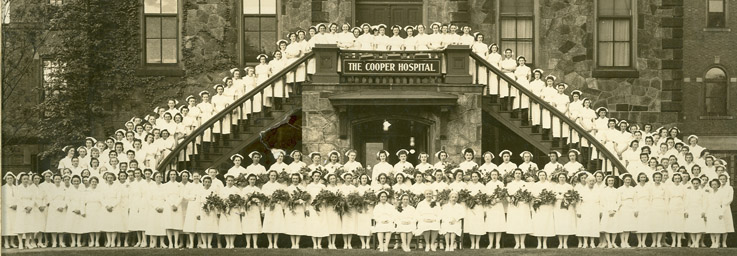
Cooper‘s roots can be traced to the mid-1870s, when Richard M. Cooper, MD, and members of his extended family donated money and land bounded by Mickle Street (now Martin Luther King Boulevard), Benson Street, 6th Street, and 7th Street for a new hospital. Guided by their Quaker roots, the prominent Camden family sought to provide medical care for the indigent population of the city. Although the four-story stone building was completed in 1877, the original 30-bed hospital stood empty for 10 years until enough money was available to open for patients in August 1887. Cooper Hospital’s original medical staff consisted of eight doctors: four general physicians and four surgeons.
Cooper Hospital quickly became a cornerstone in the Camden community. As hospital facilities and medical care advanced, Cooper’s reputation for excellence became widespread and it began to expand.
Rapid Expansion
From the very beginning, there was a pressing demand for additional services, and Cooper Hospital underwent several expansions in its early years:
1890
A training school for nurses opened.
1911
A much-needed outpatient building was completed adjacent to the hospital.
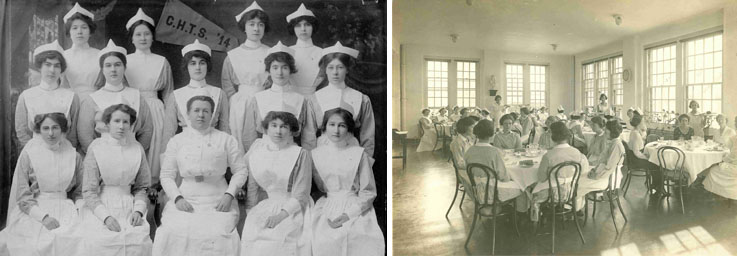
1923
A building for the hospital’s first dedicated children’s ward was completed.
1927
A three-story addition opened with private and semi-private patient rooms, an emergency department, and a commercial hospital kitchen.
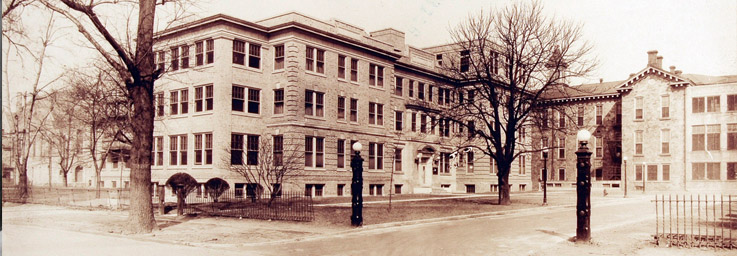
1929
A new four-story Nurses Home was built to house staff.
1941
The John Thompson Dorrance Memorial Building opened. The six-story Dorrance Building provided additional private patient rooms, family waiting rooms, operating suites, and office space.
1958
Cooper received funding to add two, seven-story “wing” additions to the Dorrance Building (still in use today). When the Dorrance wings opened in 1960 and 1961, Cooper became the largest not-for-profit hospital in New Jersey at that time.
Renewed Commitment
Despite continual growth, Cooper’s original building and many of the early expansions began showing wear reflecting years of use. At the same time, throughout the 1960s, Camden began to experience a population decline as many residents and businesses moved out of the city. Discussion among hospital leaders focused on whether Cooper should remain in Camden or build a new suburban hospital. After several years of debate, the decision was made to stay true to its founders’ mission. Cooper would remain in Camden.
With this renewed commitment, Cooper began to renovate and replace its aging infrastructure. Cooper also developed into a major regional academic health system.
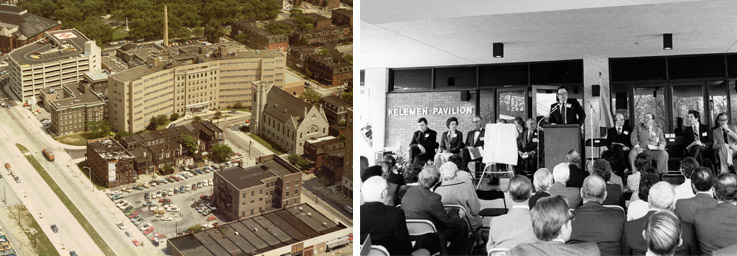
1976
After four years of planning, groundbreaking took place for a new 10-story, $38 million main building on the site of the original hospital. The Kelemen Building opened in March 1979. It was named for board member Frank Kelemen, who was credited with much of Cooper’s transformation during this time.
1977
Cooper Hospital signed an agreement to become the clinical campus of the University of Medicine and Dentistry/Robert Wood Johnson Medical School. The development of the medical school affiliation advanced Cooper University Hospital as the major teaching hospital in South Jersey.
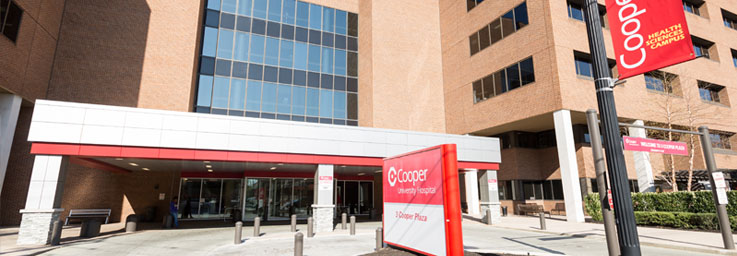
1986
An outpatient medical office facility, Three Cooper Plaza, opened along with an adjacent parking garage.
1996
Cooper University Hospital transformed into The Cooper Health System, reflecting its status as an academic, tertiary care, integrated health care delivery system.
2004
A $220 million investment in a Health Sciences Campus was announced as part of Cooper's efforts to create a regional health science hub in Camden.
2008
A new hospital building, the 10-story Roberts Pavilion, opened. The Roberts Pavilion is connected to the Dorrance and Kelemen buildings. For the first time, the hospital’s front entrance and lobby shifted from Haddon Avenue to Martin Luther King Boulevard.
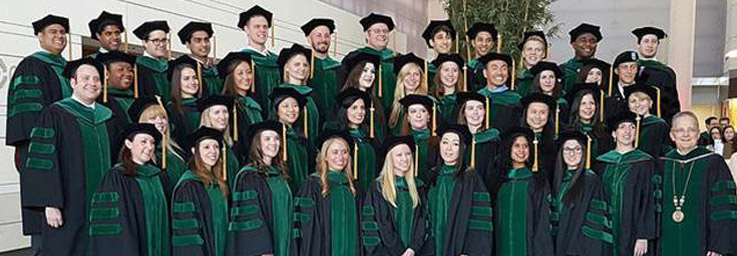
2012
After several decades of discussions, the first new medical school in New Jersey opened on the Cooper Health Sciences campus. Developed in partnership with Rowan University, Cooper Medical School of Rowan University graduated its first class in 2016.
2013
Cooper University Health Care partnered with the nation’s leading cancer center, The University of Texas MD Anderson Cancer Center in Houston, creating MD Anderson Cancer Center at Cooper across Haddon Avenue from the main hospital.
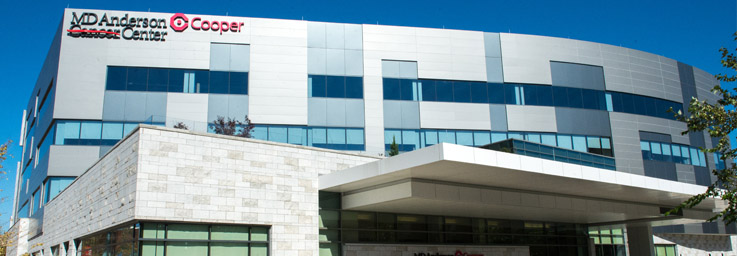
2015
Cooper University Health Care had more than 1.5 million patient visits and revenues exceeded $1 billion for the first time.
2016
MD Anderson Cancer Center at Cooper opened an inpatient cancer unit on the fifth floor of the Roberts Pavilion, featuring 30 state-of-the-art private rooms. MD Anderson Cancer Center at Cooper also opened an office in Egg Harbor Township.
Cooper teamed up with Deborah Heart and Lung Center to create HeroCare Connect to provide veterans and active military with concierge specialty services.
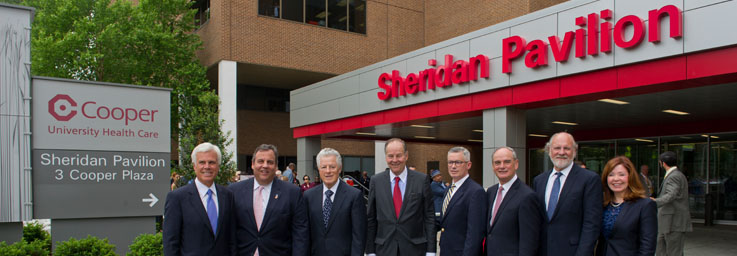
2017
Three Cooper Plaza was renamed the Sheridan Pavilion in honor of former Cooper President and CEO John Sheridan and his wife, Joyce.
The Cooper Foundation received an anonymous $22 million gift from a grateful patient to fund specialized research exploring the role of a unique line of stem cells in certain cancers, wound healing, and vision.
2018
Cooper entered into an agreement with the U.S. Army to provide advanced surgical trauma training to the Army’s elite Forward Resuscitative Surgical Team, the first in the nation to provide this training.
Cooper University Health Care and Inspira Health Network form Cardiac Partners (later renamed and now Cardiac Care). This joint venture makes Cardiac Partners the largest cardiac program in South Jersey.
Cooper upgraded its helipad for trauma transfers, constructed eight new operating rooms (bringing total system-wide ORs to 36), and added an iTrack system to improve Emergency Department patient flow.
A second KIPP Cooper Norcross Academy is dedicated: KIPP Cooper Norcross Academy John Greenleaf Whittier Middle School. The school offers guaranteed enrollment for children from adjacent neighborhoods.
Cooper launched its first biotech company, Stemplant, LLC, to market innovative cell-based therapies for treating peripheral artery disease.
2019
Cooper is the first in the world to use a new virtual reality system -- the REAL Immersive System – for patient rehabilitation after stroke.
Cooper’s innovative cogeneration facility goes online, generating 78% of the electricity needed by the campus, reducing Cooper’s environmental footprint, and guaranteeing the necessary power to provide patient care in the event of a power outage.
Cooper EMS, in collaboration with Cooper’s Addiction Medicine and Emergency Medicine divisions, becomes the first EMS system in the nation to administer the life-saving drug suboxone to patients experiencing an opioid overdose.
Cooper is the only hospital in the nation that has trained elite medical providers from every military branch; multiple local, state, and federal government agencies; and international partners. Cooper also begins recognizing military employees with under badges denoting their branch of service, and patients are recognized with a flag magnet on their door.
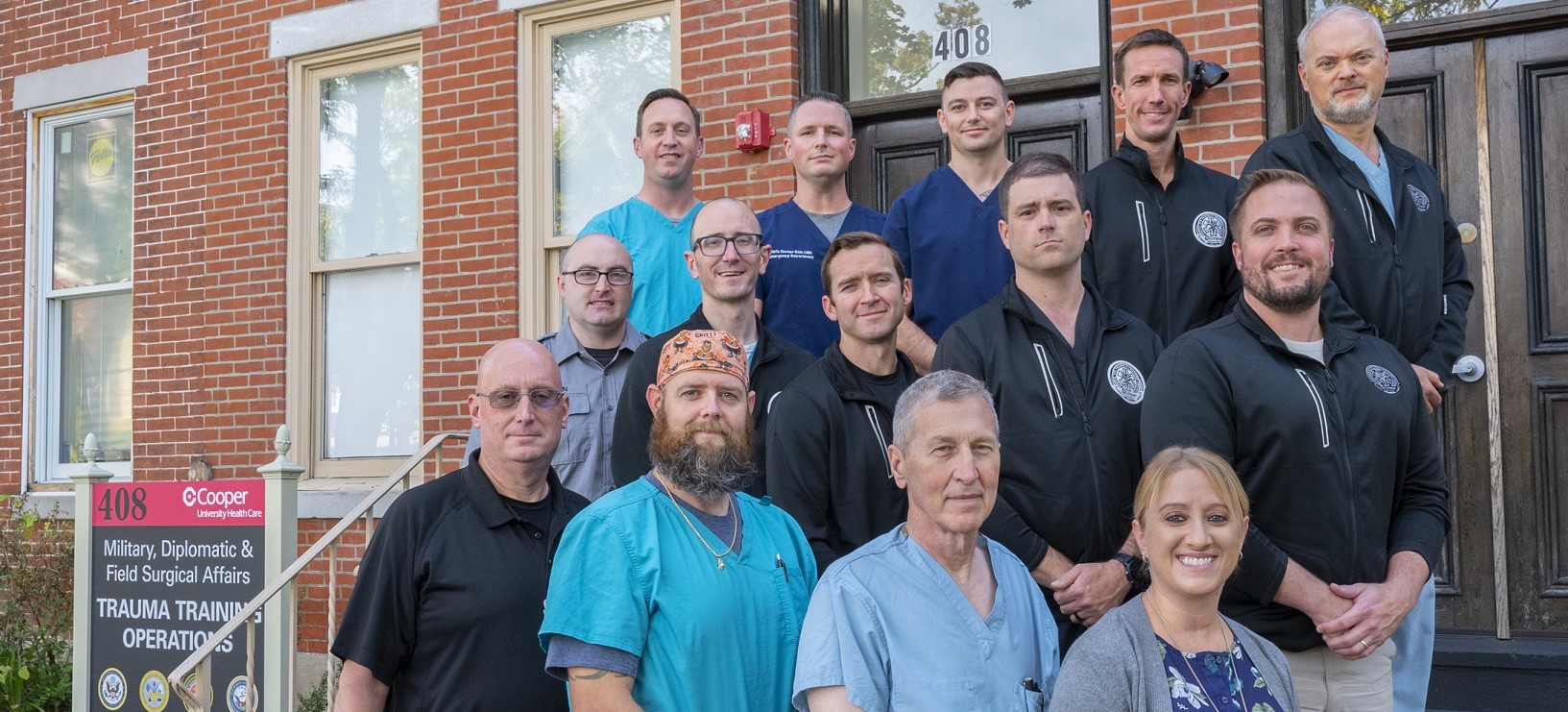
2020
During the COVID-19 pandemic, Cooper was one of three Level 1 Trauma Centers entrusted by Governor Phil Murphy and the State of New Jersey Department of Health to lead and coordinate the state's COVID-19 response in the southern New Jersey region, including testing, vaccinations, managing supplies PPE, ventilators, and critical care bed capacity. Cooper rapidly deployed telehealth programs to ensure continuity of care, upgraded facilities to reduce transmission, led education efforts in the community, and on Tuesday, December 15, 2020, became one of the first hospitals in the region to begin COVID-19 vaccinations.
2021
Cooper continued to lead the way in the COVID-19 throughout the southern New Jersey region. From March 2020 to December 2021, Cooper tested 132,507 patients for COVID-19, hospitalized 4,355 patients, distributed 121,000 vaccinations, and provided 20,600 boosters.
In 2021 alone, Cooper saw nearly 2 million patient visits, more than 33,000 hospital admissions, 73,000 Emergency Department visits, and 27,000 surgeries. Cooper is named one of the top hospitals in the region by U.S. News & World Report, achieves a third year of recognition for patient safety by Healthgrades, and is named by Forbes as one of the Best Places to Work in New Jersey.
2022
Cooper's Trauma Center - the region's busiest - celebrated its 40th anniversary in November. The Level 1 Trauma Center serves all of southern New Jersey.
On September 19, Cooper Board of Trustees Chairman, George E. Norcross, III, along with Governor Phil Murphy, former Governor Chris Christie, Congressman Donald Norcross, and Mayor Vic Carstarphen announced Project Imagine - a multi-year, $2 billion expansion to Cooper's Health Sciences Campus to meet growing patient volume. The first phase of the project will be a new, state-of-the-art hospital tower on the corner of Martin Luther King, Jr. Blvd. and Haddon Avenue. The tower will have a bridge connecting to MD Anderson Cancer Center at Cooper.
University Radiology at Cooper, a new partnership between Cooper and the largest provider of subspecialty radiology services in New Jersey, opened a new imaging center at Cooper's Cherry Hill Campus on Rt. 70.
Cooper opened a new, dedicated acute stroke and neuro interventional suite in its Emergency Department - the first of its kind in the nation - to speed the care of time-sensitive neurovascular emergencies.
Cooper opened its second Ripa Center for Women's Health and Wellness on Grove Street in Haddonfield.
2023
Cooper’s credit rating from Moody’s Investors Service was upgraded to A3, its highest rating ever.
Cooper University Health Care and Cape Regional Health System sign a Definitive Agreement to join together. When complete, this historic combination will bring together two respected health systems to expand access to specialty health services to residents and visitors of Cape May County.
Cooper University Health Care and Inspira Health form Cooper and Inspira Neuroscience, a partnership to improve local access to a comprehensive range of advanced neuroscience care including surgical and nonsurgical services related to the brain, spinal cord, and central nervous system.
2024
On July 1, Cooper University Health Care acquired Cape Regional Health System, expanding Cooper's academic health system from the Delaware River to the Jersey Shore. The hospital in Cape May Courthouse was renamed Cooper University Hospital Cape Regional. The 30 primary care, specialty care, wound care, and urgent care offices throughout the shore region's southern cape added to Cooper's growing list of more than 130 ambulatory locations.
Cooper Today
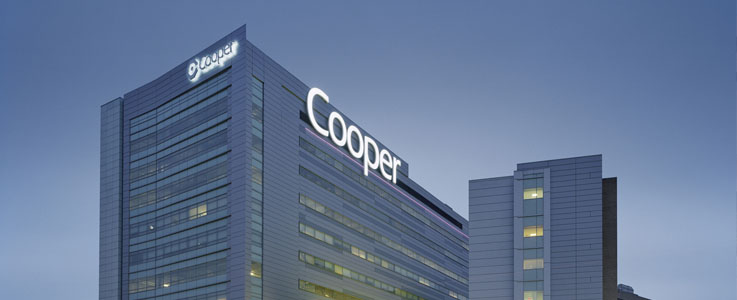
Today, Cooper University Health Care is a leading academic health system with a full range of services, including prevention, primary care, specialty services, all levels of inpatient care, and subacute care. While continuing to invest in its Camden campus, Cooper now operates two hospitals, more than 130 community-based outpatient primary and specialty care offices, and six urgent care centers to serve the health care needs of South Jersey.
